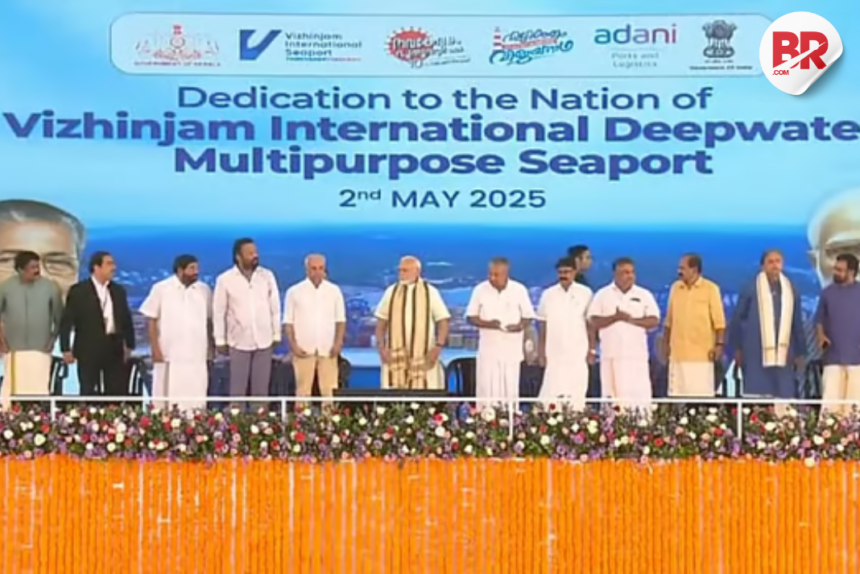
Vizhinjam International Seaport has officially opened in Kerala, and it’s no exaggeration to call this a defining moment for India’s trade future.
Launched by Prime Minister Narendra Modi, the port isn’t just another maritime facility—it’s designed to be a deep-water transhipment hub that can rival the likes of Singapore, Colombo, and Dubai.

With a natural depth of over 18 meters, Vizhinjam is one of the few Indian ports capable of handling ultra-large container vessels (ULCVs).
That means massive cargo ships sailing between Asia and Europe no longer need to rely on foreign ports to reload. For a country that currently sends about 75% of its transhipment cargo to foreign shores, that’s a big deal.
What Does This Mean for You?
For Indian businesses, Vizhinjam could mean shorter shipping times, lower logistics costs, and fewer middlemen. For consumers, it may result in cheaper products and faster deliveries.
For the average taxpayer, it’s a strategic shift that brings billions in potential savings back home instead of losing them to overseas ports.
Oh, and for anyone who’s ever cursed a delayed parcel from abroad—this is India quietly whispering: “We got this now.”
#WATCH | Kerala: PM Modi dedicates Rs 8,900 crore Vizhinjam International Deepwater Seaport to the nation in Thiruvananthapuram.
The mega port project has been developed under a public-private partnership by Adani Ports and Special Economic Zone Ltd (APSEZ).#VizhinjamPort… pic.twitter.com/cU0BU0H7Nn
— Organiser Weekly (@eOrganiser) May 2, 2025
The Game Changer India Needed
So why all the buzz around Vizhinjam?
- Natural Advantage: Its deep-water design makes it ideal for the largest cargo ships.
- Closer to Global Routes: It’s near the international east-west shipping lane—no detours needed.
- First of Its Kind: It’s India’s first mega transhipment port, meaning foreign ships can unload cargo here for redistribution across Asia and beyond.
The government’s Sagarmala initiative—which aims to modernize India’s ports—backs this move.
Benefits Beyond the Sea
1. Lower Trade Costs
Currently, transhipping through Colombo and Singapore adds time and money. Vizhinjam changes that.
2. Boost to Indian Exports
Faster, cheaper logistics means Indian products become more competitive worldwide.
3. Local Jobs and Growth
Expect thousands of direct and indirect jobs, from crane operators to tech specialists, in and around Kerala.
4. Foreign Investment Magnet
The port is likely to attract warehousing, logistics, and transport investments—paving the way for regional economic transformation.
Kerala: Prime Minister Narendra Modi says, “This seaport has been developed at a cost of eight thousand eight hundred crore. The current capacity of this transshipment hub will be tripled in the coming years… Now, the country’s money will benefit the country. The money that was… pic.twitter.com/gyREz44K0g
— IANS (@ians_india) May 2, 2025
Modi’s Message and the Road Ahead
In his speech, PM Modi emphasized Vizhinjam as part of a “New India”—self-reliant, globally competitive, and future-ready. But it hasn’t been smooth sailing. The project faced environmental protests and land acquisition hurdles. To the government’s credit, many concerns were addressed through revised plans and sustainability efforts.
Now, phase one is done. What’s next?
- Better Road and Rail Connectivity: Without last-mile infrastructure, the port can’t reach its potential.
- Modern Logistics Parks: Supporting infrastructure needs rapid scaling.
- Winning Over Global Shippers: Big liners won’t come just because you built it—you have to sell it.
PM Narendra Modi officially commissions Vizhinjam International Seaport in Kerala. pic.twitter.com/AwI3mPHpRr
— News Arena India (@NewsArenaIndia) May 2, 2025
A New Chapter for Kerala—and the Country
For Kerala, Vizhinjam isn’t just a port—it’s an identity shift. From being a tourism-centric state to becoming a global logistics player, this project could rewrite economic possibilities.
For India, it’s a message: we no longer need to outsource our shipping clout.
It’s about time we stopped paying Colombo to move our containers. With Vizhinjam, we’re finally charging rent on our own coast.
Also Read Modi Puts Kerala on the Map—But What’s the Real Story Behind Vizhinjam Port?












